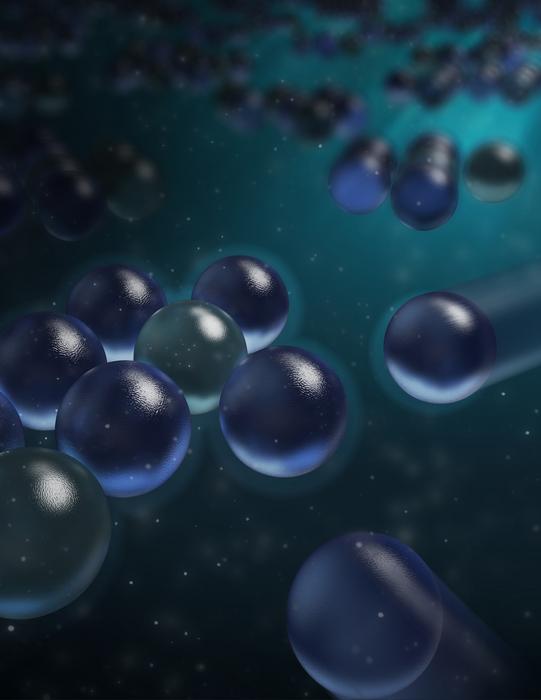‘Opposites charges attract; like charges repel’ is a fundamental principle of basic physics. But a new study from Oxford University, published today in Nature Nanotechnology, has demonstrated that similarly charged particles in solution can, in fact, attract each other over long distances. Just as surprisingly, the team found that the effect is different for positively and negatively charged particles, depending on the solvent.

Credit: Cover image: Zhang Kang.
- A study published today in Nature Nanotechnology shows that similarly charged particles can sometimes attract, rather than repel.
- The team found that like-charged particles suspended in liquids can attract one another at long-range, depending on the solvent and the sign of the charge.
- The study has immediate implications for processes that involve interactions in solution across various length-scales, including self-assembly, crystallisation, and phase separation.
‘Opposites charges attract; like charges repel’ is a fundamental principle of basic physics. But a new study from Oxford University, published today in Nature Nanotechnology, has demonstrated that similarly charged particles in solution can, in fact, attract each other over long distances. Just as surprisingly, the team found that the effect is different for positively and negatively charged particles, depending on the solvent.
Besides overturning long-held beliefs, these results have immediate implications for a range of processes that involve interparticle and intermolecular interactions across various length-scales, including self-assembly, crystallisation, and phase separation.
The team of researchers, based at Oxford’s Department of Chemistry, found that negatively charged particles attract each other at large separations whereas positively charged particles repel, while the reverse was the case for solvents such as alcohols.
These findings are surprising because they seem to contradict the central electromagnetic principle that the force between charges of the same sign is repulsive at all separations.
Now, using bright-field microscopy, the team tracked negatively charged silica microparticles suspended in water and found that the particles attracted each other to form hexagonally arranged clusters. Positively charged aminated silica particles, however, did not form clusters in water.
Using a theory of interparticle interactions that considers the structure of the solvent at the interface, the team established that for negatively charged particles in water there is an attractive force that outweighs electrostatic repulsion at large separations, leading to cluster formation. For positively charged particles in water this solvent-driven interaction is always repulsive, and no clusters form.
This effect was found to be pH dependent: the team were able to control the formation (or not) of clusters for negatively charged particles by varying the pH. No matter the pH, the positively charged particles did not form clusters.
Naturally, the team wondered whether the effect on charged particles could be switched, such that the positively charged particles form clusters and the negatives do not. By changing the solvent to alcohols, such as ethanol, which has different interface behaviour to water, this is exactly what they observed: positively charged aminated silica particles formed hexagonal clusters, whereas negatively charged silica did not.
According to the researchers, this study implies a fundamental re-calibration in understanding that will influence the way we think about processes as different as the stability of pharmaceutical and fine chemical products or the pathological malfunction associated with molecular aggregation in human disease. The new findings also provide evidence for the ability to probe properties of the interfacial electrical potential due to the solvent, such as its sign and magnitude, which were previously thought immeasurable.
Professor Madhavi Krishnan (Department of Chemistry, Oxford University), who led the study, says: ‘I am really very proud of my two graduate students, as well as the undergraduates, who have all worked together to move the needle on this fundamental discovery.’
Sida Wang (Department of Chemistry, Oxford University), a first-author on the study, says: ‘I still find it fascinating to see these particles attract, even having seen this a thousand times.’
ENDS
‘A charge-dependent long-ranged force drives tailored assembly of matter in solution’, DOI: 10.1038/s41565-024-01621-5, will be published online in Nature Nanotechnology at https://www.nature.com/articles/s41565-024-01621-5 from 10am UK time 1 March 2024, and can be accessed under embargo by journalists through Springer Nature’s press site in the usual way.
Journalists can contact:
Prof. Madhavi Krishnan, [email protected] 01865 285397, or 07423 329114
For all other press queries please contact Dr Thomas Player (Communications Manager, Department of Chemistry, University of Oxford) on [email protected]
About the University of Oxford
Oxford University has been placed number 1 in the Times Higher Education World University Rankings for the eighth year running, and number 3 in the QS World Rankings 2024. At the heart of this success are the twin-pillars of our ground-breaking research and innovation and our distinctive educational offer.
Oxford is world-famous for research and teaching excellence and home to some of the most talented people from across the globe. Our work helps the lives of millions, solving real-world problems through a huge network of partnerships and collaborations. The breadth and interdisciplinary nature of our research alongside our personalised approach to teaching sparks imaginative and inventive insights and solutions.
Through its research commercialisation arm, Oxford University Innovation, Oxford is the highest university patent filer in the UK and is ranked first in the UK for university spinouts, having created more than 300 new companies since 1988. Over a third of these companies have been created in the past five years. The university is a catalyst for prosperity in Oxfordshire and the United Kingdom, contributing £15.7 billion to the UK economy in 2018/19, and supports more than 28,000 full time jobs.
About the Department of Chemistry, University of Oxford
The department’s mission is to advance the global understanding of chemistry, and to use that knowledge to address major challenges for society. Find out more at www.chem.ox.ac.uk
Journal
Nature Nanotechnology
DOI
10.1038/s41565-024-01621-5
Article Title
A charge-dependent long-ranged force drives tailored assembly of matter in solution
Article Publication Date
1-Mar-2024




